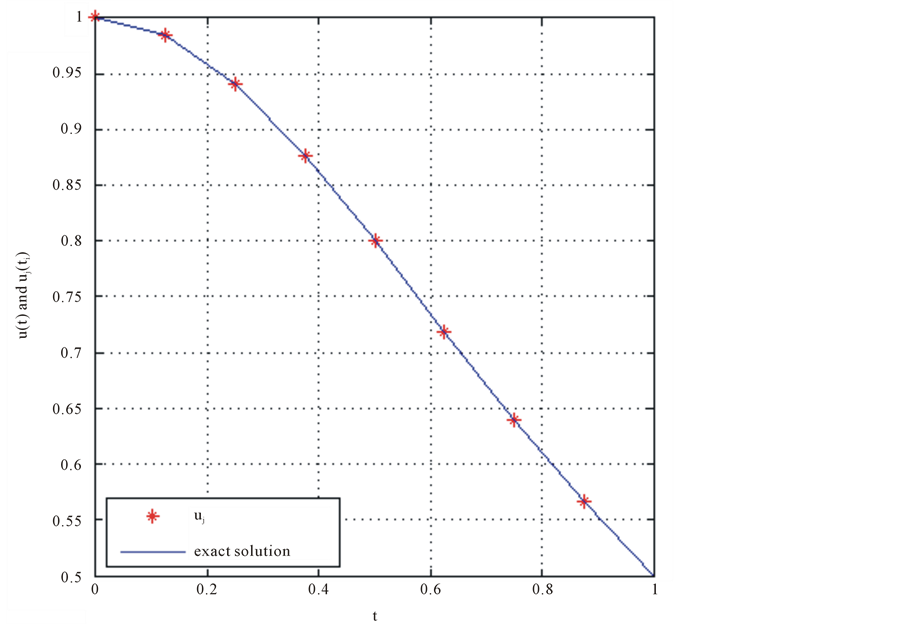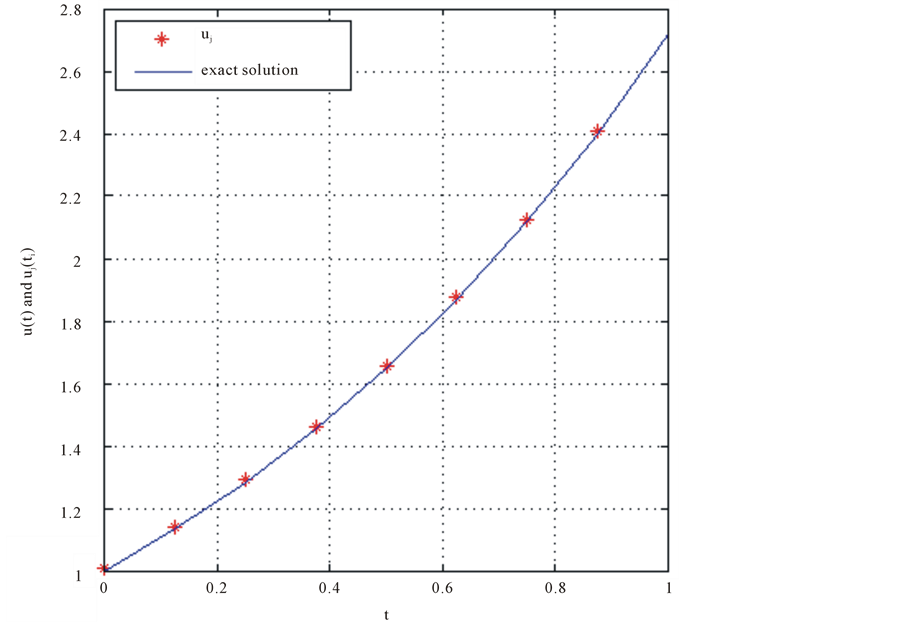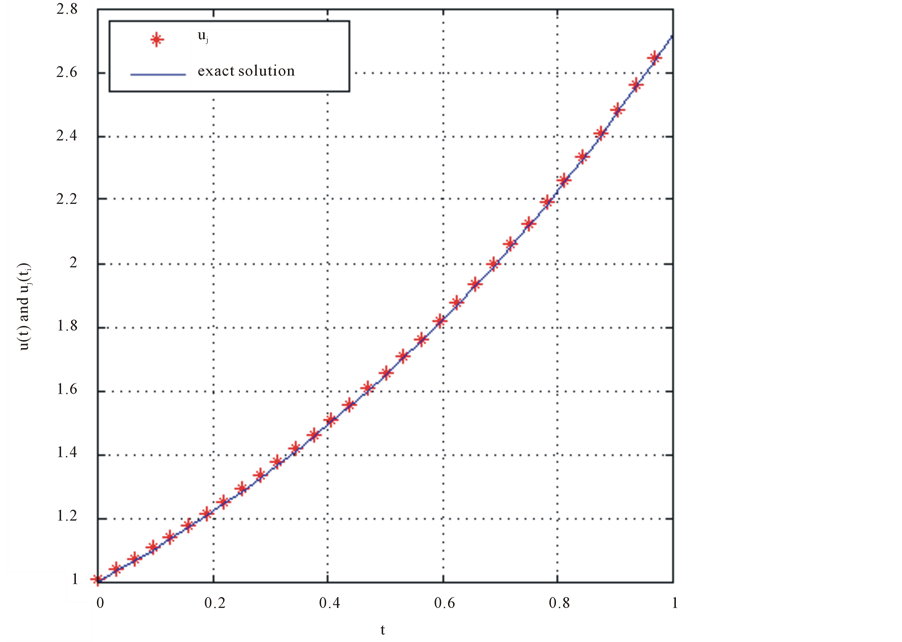Open Journal of Applied Sciences
Vol.05 No.04(2015), Article ID:55880,9 pages
10.4236/ojapps.2015.54014
Numerical Solution of Second-Order Linear Fredholm Integro-Differetial Equations by Trigonometric Scaling Functions
Hamid Safdari, Yones Esmaeelzade Aghdam
Department of Mathematics, Shahid Rajaee Teacher Training University, Tehran, Iran
Email: HSafdari@srttu.edu, yonesesmaeelzade@gmail.com
Copyright © 2015 by authors and Scientific Research Publishing Inc.
This work is licensed under the Creative Commons Attribution International License (CC BY).
http://creativecommons.org/licenses/by/4.0/



Received 17 March 2015; accepted 13 April 2015; published 22 April 2015
ABSTRACT
The main aim of this paper is to apply the Hermite trigonometric scaling function on [0, 2p] which is constructed for Hermite interpolation for the linear Fredholm integro-differential equation of second order. This equation is usually difficult to solve analytically. Our approach consists of reducing the problem to a set of algebraic linear equations by expanding the approximate solution. Some numerical example is included to demonstrate the validity and applicability of the presented technique, the method produces very accurate results, and a comparison is made with exiting re- sults. An estimation of error bound for this method is presented.
Keywords:
Numerical Technique, Fredholm Integro-Differential Equations, Hermite Trigonometric Wavelets, Operational Matrix, Error Estimates

1. Introduction
In this paper we solve the Fredholm Linear Integro-Differential Equations as
 (1)
(1)
where ,
,  , and
, and  are given functions that have suitable derivatives, and
are given functions that have suitable derivatives, and  and
and  are given real constans. In most situations, it is difficult to obtain exact solution of the above integration. Hence various approximation method have been proposed and studied. The purpose of the present paper is to develop a trigonometric Hermite wavelet approximation for the computing of the problem [1] .
are given real constans. In most situations, it is difficult to obtain exact solution of the above integration. Hence various approximation method have been proposed and studied. The purpose of the present paper is to develop a trigonometric Hermite wavelet approximation for the computing of the problem [1] .
Systems of integro-differential equations have a major role in the fields of science, physical phenomena, and engineering, such as nano-hydrodynamics, glass-forming process, dropwise condensation, wind ripple in the de- sert, and modeling the competition between tumor cells and the immune system. The concept of a system of integro-differential equations has motivated a huge amount of research work in recent years. Alot of attention has been devoted to the study of differential-difference equations, e.g. equations containing shifts of the un- known function and its derivates, and also integro-differential-difference equations. For instance, see [2] [3] . There are several numerical methods for solving system of linear integro-differential equations, for example, the rationalized Haar functions method [4] , Galerkin methods with hybrid functions [5] , the spline approximation method [6] , the Chebyshev polynomial method [7] , the spectral method [8] , the CAS wavelet method [9] , Ruge- Kutta methods [10] , the Adomian decomposition methods [11] , and the interested reader can see [12] [13] for more published research works in the subject.
Our approach consists of reducing the problem to a set of linear equations by trigonometric scaling functions which is constructed for Hermite interpolation. A difficulty of using wavelet for the representation of integral operators is that quadrature leads to potentially high cost with sparse matrix. This fact particularly encourages us in efforts to devote to some appropriate wavelet bases to simplify the computation expense of the reoresentation matrix, which is importent to improve the wavelet method. Recently, the trigonometric interpolant wavelet has arisen in the approximation of operators [14] - [16] . Quack [17] has constructed a multiresolution analysis (MRA). Chen [18] [19] presented the feasibility of trigonometric wavelet numerical methods for stokes problem and Hadamard integral equation.
The organization of the rest of this paper is as follows: Section (0) describe the trigonometric scaling function on , and construct the operational matrix of derivative for these function. Section (0) summarizes the application of trigonometric scaling functions to the solution of Problem (1). Thus, a set of linear equations is formed and a solution of the considered problem is introduced. In Section (0), we report our computational results and demonstrate the accuracy of the proposed numerical schemes by presenting numerical examples. Note that we have computed the numerical results by MATLAB programming.
, and construct the operational matrix of derivative for these function. Section (0) summarizes the application of trigonometric scaling functions to the solution of Problem (1). Thus, a set of linear equations is formed and a solution of the considered problem is introduced. In Section (0), we report our computational results and demonstrate the accuracy of the proposed numerical schemes by presenting numerical examples. Note that we have computed the numerical results by MATLAB programming.
2. Interpolatory Hermite Trigonometric Wavelets
In this section, we will give a brief introduction of Quak’s work on the construction of Hermite interpolatory trigonometric wavelets and their basic properties. More details can be found in (see [17] ).
For all , two scaling functions
, two scaling functions  and
and  are defined as
are defined as
 (2)
(2)
 (3)
(3)
where the Dirichlet kernel  and its conjugate kernel
and its conjugate kernel  are defined as
are defined as

Obviously,  , where
, where 
exceeding l. The equally spaced nodes on the interval 

any 





Lemma 1 (See [17] .) For 
and their derivations are given by
Theorem 1 (Interpolatory properties of the scaling functions). (See [17] ) For

From above we can take wavelet functions 

Definition 2 (Scaling functions space). For all 

As a first step of studying the spaces
Now a Hermite-type project operator can be introduced by means of the scaling functions. For all 




where




Theorem 3 Let

where C is a positive constant value.
Proof. See [17] .
Lemma 2 (The operational matrix of scaling function derivative). (See [20] ) The differentiation of vector 
where 


where 


where 




where 





Using 7 and 

and

for
3. Procedure Solution Using the Trigonometric Scaling Function
In this section, we first give the computational schemes for Equation (1) with the Newton-Cotes formulas. For either one of these rules, we can make a more accurate approximation by breaking up the interval 

where the subintervals have the form


basis 



where C is 




Thus we have

By using Lemma 2 and after summarizing Equation (13) can be rewritten as the matrix form 





where the matrix





4. Numerical Example
To support our theoretical discussion, we applied the method presented in this paper to several examples. The main objective here is to solve these two examples using the trigonometric scaling function and compare our results with exact solution.
Example 4 Consider the second-order the Fredholm Linear Integro-Differential Equation
with the mixed conditions 


apply the suggested method with 




In Table 2 we compare the new method with



Example 5 Consider the following second-order the Fredholm Linear Integro-Differential Equation
with the initial conditions



Table 1. The maximum error matrix A from Example 4.
Table 2. Error analysis and numerical results of Example 4.
Table 3. The maximum error matrix A from Example 5.
Figure 1. Result EX.4 for J = 1 and N = 7; Result EX.4 for J = 2 and N = 7.
Figure 2. Result EX.5 for J = 1 and N = 7; Result EX.5 for J = 2 and N = 7.
Table 4. Error analysis and numerical results of Example 5.
5. Conclusion
Our results indicate that the method with the trigonometric scaling bases can be regarded as a structurally simple algorithm that is conventionally applicable to the numerical solution of IDEs. In addition, although we have re- stricted our attention to linear Fredholm IDEs, we expect the method to be easily extended to more general IDEs. the presented method which is based on the trigonometric scaling function is proposed to find the approximate solution. A comparison of the exact solution reveals that the presented method is very effective and convenient. Nevertheless, as Figure 1 and Figure 2 illustrate, the error of the trigonometric scaling bases shows that the accuracy improves with increasing J, hence for better results, using number J is recommended. Also form the obtained approximate solution, we can conclude that the proposed method gives the solution in an excellent agree- ment with the exact solution. All computations are done using MATLAB programming.
Acknowledgements
The authors are very grateful to the editor for carefully reading the paper and for their comments and sugges- tions which have improved the paper.
References
- Desmond, R.A., Weiss, H.L., Arani, R.B., Soong, S.-J., Wood, M.J., Fiddian, P., Gnann, J. and Whitley, R.J. (2002) Clinical Applications for Change-Point Analysis of Herpes Zoster Pain. Journal of Pain and Symptom Management, 23, 510-516. http://dx.doi.org/10.1016/S0885-3924(02)00393-7
- Wazwaz, D.D., Dimitrova, M.B. and Dishliev. A.B. (2000) Oscillation of the Bounded Solutions of Impulsive Differential-Difference Equations of Second Order. Applied Mathematics and Computation, 114, 61-68. http://dx.doi.org/10.1016/S0096-3003(99)00102-2
- Gulsu, M. and Sezer, M. (2006) A Taylor Polynomial Approach for Solving Differential-Difference Equations. Journal of Computational and Applied Mathematics, 186, 349-369. http://dx.doi.org/10.1016/j.cam.2005.02.009
- Maleknejad, K., Mirzaee, F. and Abbasbandy, S. (2004) Solving Linear Integro-Differential Equations System by Using Rationalized Haar Functions Method. Applied Mathematics and Computation, 155, 317-328. http://dx.doi.org/10.1016/S0096-3003(03)00778-1
- Maleknejad, K., Tavassoli, M. and Kajani, M. (2004) Solving Linear Integro-Differential Equation by Galerkin Methods with Hybrid Functions. Journal of Computational and Applied Mathematics, 159, 603-612. http://dx.doi.org/10.1016/j.amc.2003.10.046
- Ganesh, M. and Sloan, I.H. (1999) Optimal Order Spline Methods for Nonlinear Differential and Integro-Differential Equations. Applied Numerical Mathematics, 29, 445-478. http://dx.doi.org/10.1016/S0168-9274(98)00067-1
- Dascoglua, A. and Sezer, M. (2005) Chebyshev Polynomial Solutions of Systems of Higher-Order Linear Fredholm- Volterra Integro-Differential Equations. Journal of the Franklin Institute, 342, 688-701. http://dx.doi.org/10.1016/j.jfranklin.2005.04.001
- Faour, A.L. and Saeed, R.K. (2006) Solution of a System of Linear Volterra Integral and Integro-Differential Equations by Spectral Method. Journal of Al-Nahrain University/Science, 62, 30-46.
- Danfu, H. and Xufeng, A.S. (2007) Numerical Solution of Integro-Differential Equations by Appling CAS Wavelet Operational Matrix of Integration. Applied Mathematics and Computation, 194, 460-466. http://dx.doi.org/10.1016/j.amc.2007.04.048
- Baker, C. and Tang, A. (1997) Stability of Continuous Implicit Runge-Kutta Methods for Volterra Integro-Differential Systems with Unbounded Delays. Applied Numerical Mathematics, 24, 153-173. http://dx.doi.org/10.1016/S0168-9274(97)00018-4
- El-Sayed, S., Kaya, D. and Zarea, S. (2004) The Decomposition Method Applied to Solve High Order Linear Volterra- Fredholm Integro-Differential Equations. International Journal of Nonlinear Sciences and Numerical Simulation, 52, 105-112.
- Sezer, M. and Gulsu, M. (2007) Polynomial Solution of the Most General Linear Fredholm-Volterra Integro Differential- Difference Equations by Means of Taylor Collocation Method. Applied Mathematics and Computation, 185, 646-657. http://dx.doi.org/10.1016/j.amc.2006.07.051
- Sezer, M. and Gulsu, M. (2005) A New Polynomial Approach for Solving Difference and Fredholm Integro-Difference Equations with Mixed Argument. Applied Mathematics and Computation, 171, 332-344. http://dx.doi.org/10.1016/j.amc.2005.01.051
- Chui, C.K. and Mhaskar, H.N. (1993) On Trigonometric Wavelets. Constructive Approximation, 9, 167-190. http://dx.doi.org/10.1007/BF01198002
- Prestin, J. (2001) Trigonometric Wavelets. In: Jain, P.K., et al., Eds., Wavelet and Allied Topics, Narosa Publishing House, New Delhi, 183-217.
- Themistoclakis, W. (1999) Trigonometric Wavelet Interpolation in Besov Spaces. Facta Univ. (Nis) Ser. Math. Inform, 14, 49-70.
- Quak, E. (1996) Trigonometric Wavelets for Hermite Interpolation. Department of Mathematics, Texas A. M. University, 65, 683-722.
- Chen, W.S. and Lin, W. (1997) Hadamard Singular Integral Equations and Its Hermite Wavelet Methods. Proceedings of the 5th International Colloquium on Finite Dimensional Complex Analysis, Beijing, 13-22.
- Chen, W.S. and Lin, W. (2002) Trigonometric Hermite Wavelet and Natural Integral Equations for Stockes Problem. International Conference on Wavelet Analysis and Its Applications, Guangzhou, 73-86.
- Lakestani, M. and Saray, B.N. (2010) Numerical Solution of Telegraph Equation Using Interpolating Scaling Functions. Computer and Mathematics with Application, 60, 1964-1972. http://dx.doi.org/10.1016/j.camwa.2010.07.030





























